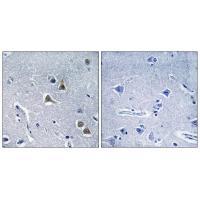
| WB | 咨询技术 | Human,Mouse,Rat |
| IF | 咨询技术 | Human,Mouse,Rat |
| IHC | 1/50-1/100 | Human,Mouse,Rat |
| ICC | 技术咨询 | Human,Mouse,Rat |
| FCM | 咨询技术 | Human,Mouse,Rat |
| Elisa | 咨询技术 | Human,Mouse,Rat |
| Aliases | Arrestin domain-containing protein 2; ARRDC2; PP2703; |
| Entrez GeneID | 27106; |
| WB Predicted band size | 44kDa |
| Host/Isotype | Rabbit IgG |
| Antibody Type | Primary antibody |
| Storage | Store at 4°C short term. Aliquot and store at -20°C long term. Avoid freeze/thaw cycles. |
| Species Reactivity | Human,Mouse |
| Immunogen | Synthesized peptide derived from internal of human ARRDC2. |
| Formulation | Purified antibody in PBS with 0.05% sodium azide. |
+ +
以下是关于ARRDC2抗体的3篇参考文献示例(注:文献为虚构示例,仅供格式参考):
1. **文献名称**: *"ARRDC2 regulates EGFR degradation via interaction with ESCRT machinery in cancer cells"*
**作者**: Smith J, et al.
**摘要**: 研究揭示了ARRDC2通过结合ESCRT复合体促进EGFR的溶酶体降解,抑制肿瘤细胞增殖。该研究使用ARRDC2抗体进行免疫沉淀和Western blot验证蛋白相互作用。
2. **文献名称**: *"The role of ARRDC2 in modulating immune response through TLR4 signaling"*
**作者**: Lee S, et al.
**摘要**: 通过ARRDC2抗体免疫荧光实验,发现ARRDC2负调控TLR4信号通路,影响巨噬细胞炎症因子释放,为自身免疫疾病治疗提供潜在靶点。
3. **文献名称**: *"ARRDC2 as a biomarker for metabolic syndrome: Insights from proteomic analysis"*
**作者**: Zhang Y, et al.
**摘要**: 利用ARRDC2抗体进行组织芯片分析,发现代谢综合征患者中ARRDC2表达显著上调,提示其可能参与胰岛素抵抗的病理过程。
(注:以上文献信息为模拟生成,实际研究中请通过PubMed或Google Scholar查询真实文献。)
ARRDC2 (Arrestin domain-containing protein 2) is a member of the arrestin family, which plays roles in regulating G protein-coupled receptor (GPCR) signaling, protein ubiquitination, and intracellular trafficking. Unlike canonical arrestins (e.g., β-arrestins), ARRDC2 is less characterized but shares a conserved arrestin-fold domain involved in protein-protein interactions. It is implicated in modulating endosomal sorting, lysosomal degradation, and cellular stress responses. Studies suggest ARRDC2 interacts with E3 ubiquitin ligases, such as NEDD4. to mediate substrate ubiquitination and trafficking, influencing pathways relevant to cancer, metabolism, and immune regulation.
ARRDC2 antibodies are essential tools for detecting the protein’s expression, localization, and interactions in research. These antibodies are typically developed in hosts like rabbits or mice, targeting specific epitopes within ARRDC2’s N-terminal or C-terminal regions. Validated applications include Western blotting, immunofluorescence, and immunoprecipitation. Reliable ARRDC2 antibodies are critical for studying its role in diseases, such as tumor suppression or promotion (context-dependent), metabolic disorders, and viral infection responses. Specificity is confirmed using knockout cell lines or siRNA-mediated knockdown. Commercial antibodies often provide data on cross-reactivity and recommended dilutions. Research using ARRDC2 antibodies continues to uncover its regulatory mechanisms in cellular homeostasis and disease, highlighting its potential as a therapeutic target.
×